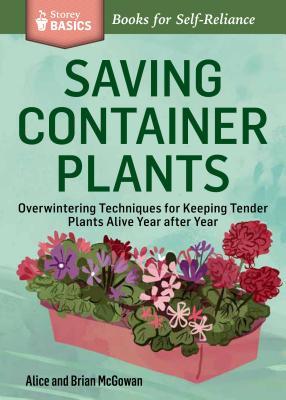 In Alice and Brian McGowan's new book, Saving Container Plants, they give their readers a solid walk through to saving a wide variety of plants that it's fairly likely their readers were rebuying year after year in order to enjoy them year after year. Of course, that's wasteful, and so the McGowans have stepped up to the plate and offered some detailed advise on how to keep those tender plants alive without the benefit of the climates to which the plants are accustomed. As a gardener at the northern edge of zone 5, I appreciate their advice tremendously.
In Alice and Brian McGowan's new book, Saving Container Plants, they give their readers a solid walk through to saving a wide variety of plants that it's fairly likely their readers were rebuying year after year in order to enjoy them year after year. Of course, that's wasteful, and so the McGowans have stepped up to the plate and offered some detailed advise on how to keep those tender plants alive without the benefit of the climates to which the plants are accustomed. As a gardener at the northern edge of zone 5, I appreciate their advice tremendously.A great thing about Saving Container Plants is that Alice and Brian McGowan don't assume the reader knows a thing about keeping a plant alive indoor or out of doors, and they don't assume the reader has remembered that they want to protect their floors or furniture from their containers, so they even remind the reader of the little things like saucers under the pots. They also point out that some plants, particularly tropical ones, are probably going to like to be treated like houseplants and enjoy sitting in a sunny window or even benefit from artificial light, at room temperature, but that doesn't apply to all of the plants one might want to save. Drawing a distinction between plants based on origin, the authors outline different environments better suited to plants which require various degrees of dormancy during the winter months. Yes, Virginia, that may even mean putting some plants in a dark cold closet. Really. I know I had heard of overwintering some bulbs in boxes or bags before, but hadn't really read up on it before this, but now it makes a lot more sense.
In addition to outlining basics like how to meet the needs of tender perennials based on their origins, Saving Container Plants delves into techniques for taking cuttings to save a plant for the next season while saving space, as well as options for transplanting and downsizing larger plants for the same reason.
The plant by plant breakdown of overwintering, propagation, and common pest problems is probably my favorite portion of the book, because if you know what you have, it can help a gardener quickly determine what to do with it, or if overwintering it is something feasible for his/her space, energy, and commitment level. I do admit a twinge of guilt on reading the Aloe section as I didn't expect our sudden hard freeze that came so early last fall, and all my aloe died. I'll get it right this year. Promise.
Having Saving Container Plants on hand has also given me the courage to try try again to overwinter fuchsia. It is one of my favorite not-quite-hardy-enough-to-actually-grow-here plants, and my kids enjoy the berries all summer, so this year, we'll see if we can make a go of keeping it alive year round. I think if I couple a little tenacity with the advice in this book, I can do it.
All in all, I liked Saving Container Plants: Overwintering Techniques for Keeping Tender Plants Alive Year after Year. It contains a wealth of information to help keep one's plants healthy, and the words of wisdom necessary to keep it from overtaking one's entire home. I admit a moment's disappointment that my eye-candy seeking wasn't particularly rewarded this time. I freely admit that one of the reasons I garden and read gardening books is I like pictures of plants. The many gradations of greens always please me and I feel like I learn a lot from photos. That said, I think that in choosing to go the route of illustration, Saving Container Plants gains something for limiting distraction and focusing the reader's eye on what they're going to actually be looking for in practice. Besides, dormant plants aren't exactly the most photogenic.
*I received an advanced reader copy of this book, only, in return for an honest review.

No comments:
Post a Comment